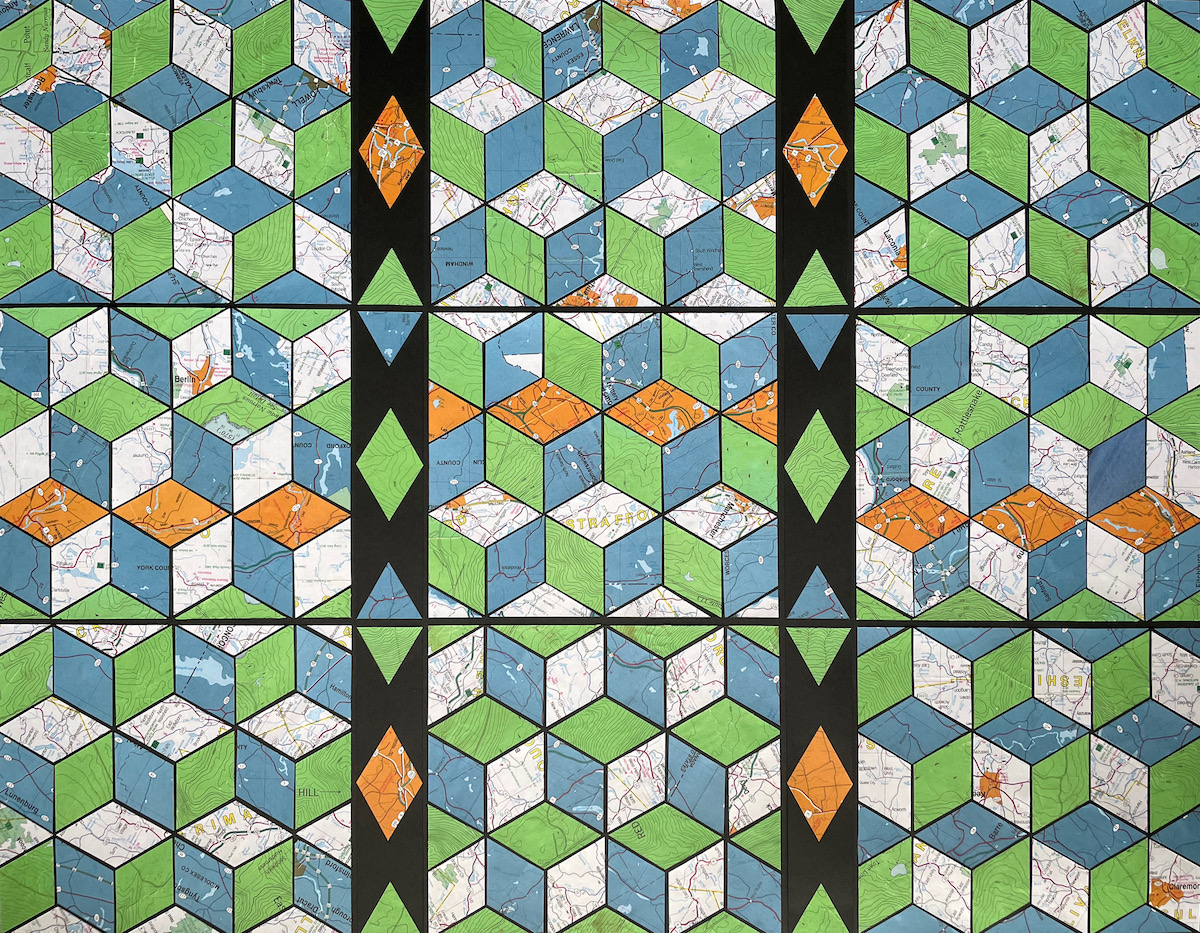Untitled New Hampshire by circe dunnell, 20″ x 26″, maps & matte medium on paper, 2021
How do we orient ourselves in disorienting times?
The January 6 United States Capitol attack and the ever-rising political polarization a year later are just two signs of our chaotic age. Add to the mix climate change, the Covid-19 pandemic, the increasing prevalence of conspiracy theories (and those who believe them, so many tending to question the veracity of facts themselves), and we might well wonder: how do we find our way now?
“Former norms no longer seem to apply,” says circe dunnell, reflecting on her own experience of dislocation.
In addition to living with the same social vertigo as the rest of us, circe has faced her own Covid-related challenges in recent months: being a teacher at a K-12 school navigating unfathomable uncertainties; unable to assist her brother in caring for an elderly parent living in New Hampshire (circe lives in New Jersey); having a partner in and out of New York hospitals during peak days of the pandemic (for non-Covid reasons).
“I have felt so out of place,” she says. “Not being able to have contact with friends; trying to teach art remotely; not being able to see my father.”
Circe has found this moment of disorientation vexing for her art as well.
Over the past 20 years, she has used maps in her art with their functionality in mind: in a 2018 series, she incorporated paper lattices made from painstakingly cutting roads out of maps, preserving route numbers and geographic legibility; in 2019, she deployed maps in works to pinpoint where discriminatory redlining took place; other works from that same year use maps to locate where incidents of gender discrimination occurred.
Maps as maps – an essential aspect of her work’s content.
“I’ve used maps in my work for a very long time – it’s through maps I’ve tried to find a direction,” she says. “But if I were to pull out a compass now I feel it might not point north – it might point anywhere.”
In a world turned upside-down, for circe, maps have lost much of their practicality – but not their appeal.
“I really liked the idea of finding some sort of grounding direction with maps in these untethered times.”
A subtle fact of circe’s past art is that the maps embedded in them are all photocopies of maps. A self-proclaimed accumulator of things, circe had always refused herself permission to use the actual maps in her art (“I was afraid of not having the original and wanting it for something else”). However, in this moment of paradigm breakdown, maps now suspect (in a sense, devalued), something clicked over: why not use the actual map?
Boldly, circe set about cutting up a New Hampshire map from her collection.
“That was pretty traumatizing – I worried about never having the map again. But as I cut it up and began to rearrange the parts together, I could see it working. I wasn’t getting the quietness in the order that I wanted, but I could see: I could cut up the maps now.”
 Detail from the first piece circe made cutting up an actual map
Detail from the first piece circe made cutting up an actual map
And that’s what she’s been doing since that point – maps cut up beyond any utility, fragments repurposed into repetition and pattern, culminating as new art.
Such is the case with New Hampshire Untitled, the work featured at the head of this article.
Made from a lake chart and map of New Hampshire, the piece looks anything but map-like. The work becomes a visual experience on its own terms, distinct from geography – like a mantra composed of shape and color, intricate in its geometry, soothing in its rhythmic repetition. Like visual music – quiet and meditative, with no overt purpose beyond existing for itself.
“With past work, I had always set out with the intention of making it about things – redlining, gender issues – using the maps in a literal way to support that content. With these works, I’m not using maps the way they were meant to be used – I’m not looking out into the world. I’m turning inward to try to find direction… to stop thinking about all the exterior stuff and how displaced I feel. I’m trying to create some order and structure so I can feel like myself again.”
Initially, circe fretted over the works’ imperfections – the varying space between each parallelogram no matter how precisely she tried to lay each paper tile.
“I struggled with the imperfections, and then I thought: why? It’s a part of it, it’s a part of me – mistakes are a part of life.”
Reckoning with fallibility while striving for an ideal is the essential story of circe’s new work – a story especially apt in such fallible times. In a world with so much falling apart, it’s a story of orienting oneself in disorienting times.
It’s story of circe using authentic maps, repurposing them, and finding her authentic self.
“This new work gives me a concrete idea of who I am as an artist. I didn’t expect that to happen. The art is coming from such a quiet place – it makes me just want to go to my studio and get to that quiet place, a place that has allowed me to finally just accept I need to make art, and that’s all I want to do.”
A big and positive change for circe, and a model for the rest of us.
Circe dunnell is an artist and teaches art at Rutgers Preparatory School in Franklin Township, New Jersey. Untitled New Hampshire and several other recent works by circe are on view at the Rotunda Gallery in Jersey City, New Jersey, through January 31.

